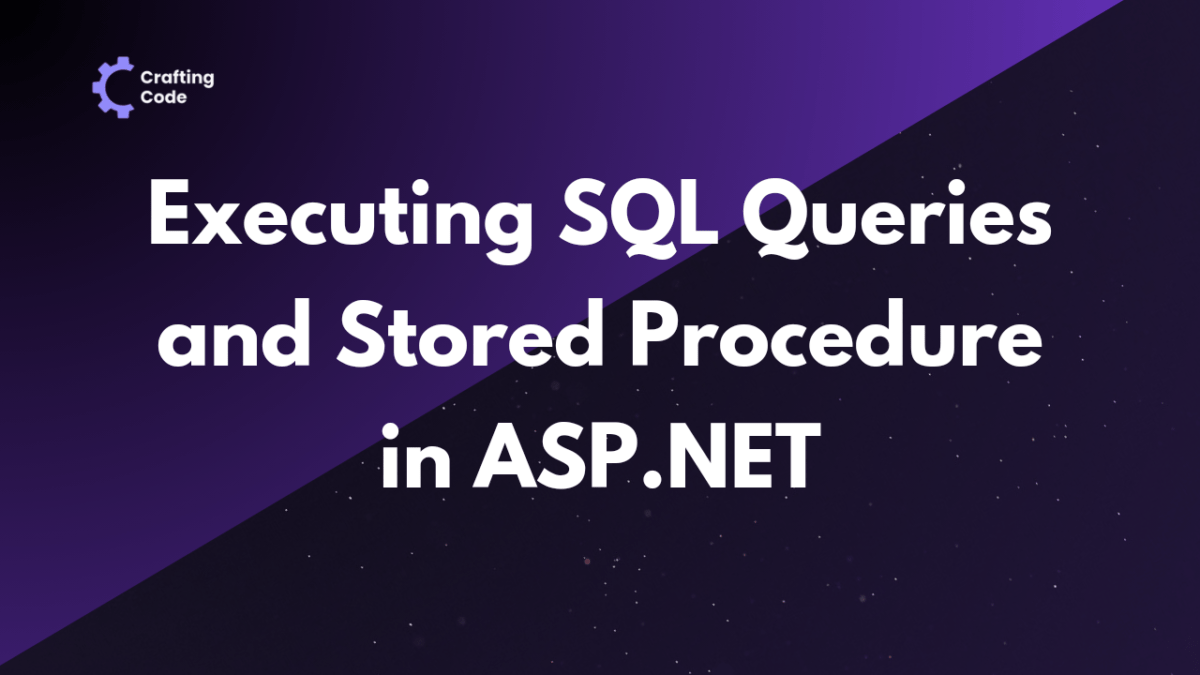Executing SQL queries and Stored Procedures in ASP.NET involves several key steps. First, establish a connection to the database by configuring connection strings in the web.config file, ensuring proper authentication and server details. Next, create a SqlCommand object to execute queries or stored procedures, specifying the appropriate CommandType based on the task at hand. Execute the command, retrieve results using a SqlDataReader, and handle exceptions using try-catch blocks for robust error handling. Additionally, implement security measures such as parameterization with SqlParameter objects to prevent SQL injection attacks.
SQL (Structured Query Language) queries serve as the fundamental means to interact with relational databases. They enable developers to retrieve, manipulate, and manage data stored in database tables. SQL queries can be categorized into various types, including SELECT (for data retrieval), INSERT (for data insertion), UPDATE (for data modification), and DELETE (for data deletion).
Stored procedures, on the other hand, are precompiled sets of SQL statements stored in the database. These procedures can accept parameters, perform complex operations, and return results. They offer several advantages, such as improved performance, security, and maintainability, making them a valuable asset in database-driven applications.
This article will provide a comprehensive guide on executing SQL queries and stored procedures in ASP.NET applications. It will cover various aspects, including:
Connecting to the Database
Establishing a connection to a database is a fundamental aspect of ASP.NET development, enabling applications to interact with data stored in a backend database management system (DBMS) such as Microsoft SQL Server, MySQL, or PostgreSQL. In ASP.NET, database connections are managed using the ADO.NET framework, which provides classes and methods for connecting to databases, executing queries, and processing results efficiently.
Connection Strings
A connection string is a string that specifies information about the data source and the means of connecting to it. It typically includes details such as the server name or IP address, database name, authentication credentials, and other parameters required to establish a connection. Connection strings are crucial in ASP.NET applications as they provide the necessary information for connecting to the database. They are usually stored in configuration files (such as web.config) and retrieved programmatically during runtime.
<configuration>
<connectionStrings>
<add name="MyDBConnection"
connectionString="Data Source=myServerAddress;Initial Catalog=myDataBase;User Id=myUsername;Password=myPassword;"
providerName="System.Data.SqlClient" />
</connectionStrings>
</configuration>
In this example:
- The
nameattribute specifies a unique name for the connection string, which can be referenced in the code. - The
connectionStringattribute contains the necessary information to connect to the database, including the server address (Data Source), initial catalog (database name), user ID, and password. - The
providerNameattribute specifies the ADO.NET provider to use, which in this case is"System.Data.SqlClient"for connecting to a Microsoft SQL Server database.
This connection string can then be accessed in your ASP.NET code using the ConfigurationManager.ConnectionStrings collection, like so:
string connectionString = ConfigurationManager.ConnectionStrings["MyDBConnection"].ConnectionString;This retrieves the connection string named “MyDBConnection” from the web.config file, allowing you to establish a database connection programmatically in your ASP.NET application.
How to establish a database connection in ASP.NET
In ASP.NET, establishing a database connection involves creating a connection object, setting its properties (including the connection string), and opening the connection to the database. Below is a simple example demonstrating how to establish a connection to a Microsoft SQL Server database using C# code:
using System.Data.SqlClient;
// Define the connection string
string connectionString = "Data Source=myServerAddress;Initial Catalog=myDataBase;User Id=myUsername;Password=myPassword;";
// Create a SqlConnection object
SqlConnection connection = new SqlConnection(connectionString);
try
{
// Open the connection
connection.Open();
// Connection established successfully
}
catch (SqlException ex)
{
// Handle connection errors
Console.WriteLine("Error connecting to the database: " + ex.Message);
}
finally
{
// Close the connection (if open)
if (connection.State == System.Data.ConnectionState.Open)
{
connection.Close();
}
}
In this example, we create a SqlConnection object and provide the connection string as a parameter to its constructor. We then attempt to open the connection using the Open() method within a try-catch block to handle any potential exceptions. Finally, we ensure the connection is closed in the finally block to release any allocated resources.
Executing SQL Queries
In ASP.NET, executing SQL queries directly involves creating SqlCommand objects and using them to execute SQL commands against a database connection. This approach allows developers to perform various database operations such as SELECT, INSERT, UPDATE, and DELETE directly from their ASP.NET applications.
Step-by-step guide to executing SELECT, INSERT, UPDATE, and DELETE queries
Syntax for executing each type of query:
- SELECT query:
string sqlSelectQuery = "SELECT * FROM TableName";
SqlCommand command = new SqlCommand(sqlSelectQuery, connection);
SqlDataReader reader = command.ExecuteReader();- INSERT query:
string sqlInsertQuery = "INSERT INTO TableName (Column1, Column2) VALUES (@Value1, @Value2)";
SqlCommand command = new SqlCommand(sqlInsertQuery, connection);
command.Parameters.AddWithValue("@Value1", value1);
command.Parameters.AddWithValue("@Value2", value2);
int rowsAffected = command.ExecuteNonQuery();
- UPDATE query:
string sqlUpdateQuery = "UPDATE TableName SET Column1 = @NewValue WHERE ConditionColumn = @Condition";
SqlCommand command = new SqlCommand(sqlUpdateQuery, connection);
command.Parameters.AddWithValue("@NewValue", newValue);
command.Parameters.AddWithValue("@Condition", condition);
int rowsAffected = command.ExecuteNonQuery();- DELETE query:
string sqlDeleteQuery = "DELETE FROM TableName WHERE ConditionColumn = @Condition";
SqlCommand command = new SqlCommand(sqlDeleteQuery, connection);
command.Parameters.AddWithValue("@Condition", condition);
int rowsAffected = command.ExecuteNonQuery();
Handling parameters to prevent SQL Injection
It’s crucial to use parameterized queries to prevent SQL injection attacks. Parameters are placeholders in SQL commands that are replaced with actual values during execution, ensuring that user input is treated as data rather than executable code.
Example code snippets for executing SQL queries:
Here are examples demonstrating the execution of SQL queries using parameterized commands:
- Example of executing a SELECT query
string sqlSelectQuery = "SELECT * FROM Employees WHERE Department = @Department";
SqlCommand command = new SqlCommand(sqlSelectQuery, connection);
command.Parameters.AddWithValue("@Department", department);
SqlDataReader reader = command.ExecuteReader();- Example of executing an INSERT query
string sqlInsertQuery = "INSERT INTO Employees (Name, Age) VALUES (@Name, @Age)";
SqlCommand command = new SqlCommand(sqlInsertQuery, connection);
command.Parameters.AddWithValue("@Name", name);
command.Parameters.AddWithValue("@Age", age);
int rowsAffected = command.ExecuteNonQuery();
These examples illustrate the process of executing SQL queries in ASP.NET, emphasizing the importance of parameterization for security.
Executing Stored Procedures
Stored procedures are precompiled sets of SQL statements stored in the database. They offer several benefits, including improved performance, reduced network traffic, and enhanced security. Stored procedures can encapsulate complex business logic and database operations, promoting code reuse and maintainability in ASP.NET applications.
Steps for executing stored procedures in ASP.NET
- Creating a SqlCommand object: To execute a stored procedure, create a SqlCommand object and specify the stored procedure name as the command text.
- Specifying the CommandType as StoredProcedure: Set the CommandType property of the SqlCommand object to StoredProcedure to indicate that you’re executing a stored procedure.
- Adding parameters to the stored procedure: If the stored procedure requires parameters, add them to the SqlCommand object using SqlParameter objects. Parameters help prevent SQL injection and provide a way to pass values to the stored procedure.
- Executing the stored procedure: Use the ExecuteNonQuery, ExecuteReader, or ExecuteScalar method of the SqlCommand object to execute the stored procedure, depending on whether the procedure returns rows, a single value, or performs non-query operations.
Example code snippets for executing stored procedures
Here’s an example demonstrating how to execute a stored procedure in ASP.NET:
public DataSet GetStudentData(string studentId, string academicYear)
{
DataSet ds = new DataSet();
try
{
// Define parameters using array initialization
SqlParameter[] myparams = new SqlParameter[]
{
new SqlParameter("@StudentId", studentId),
new SqlParameter("@AcademicYear", academicYear)
};
// Execute stored procedure with parameters
ds = SqlHelper.ExecuteDataset(conn, CommandType.StoredProcedure, "usp_GetStudentData", myparams);
}
catch (Exception ex)
{
// Handle exception
Console.WriteLine("Error: " + ex.Message);
}
return ds;
}
In this example:
- We have a method named
GetStudentDatathat retrieves student data based on a student’s ID and academic year. - Parameters
@StudentIdand@AcademicYearare used to filter the student data. - The method constructs SqlParameter objects directly within the method body for each parameter.
- The stored procedure named
usp_GetStudentDatais executed with the specified parameters to fetch the student data.
Choosing the Right Method for Executing SQL Commands
When working with databases in ASP.NET applications, we’ve several options for executing SQL commands, each suited to different scenarios. The common methods are ExecuteDataset, ExecuteNonQuery, ExecuteReader and ExecuteScalar, each with its own purpose and usage. Understanding the differences between these methods is crucial for selecting the appropriate approach based on your application’s requirements.
Choosing the Right Approach
When deciding between ExecuteDataset, ExecuteNonQuery, ExecuteReader and ExecuteScalar, consider the nature of the SQL command and the desired outcome:
| Feature | ExecuteDataset | ExecuteNonQuery | ExecuteScalar | ExecuteReader |
| Purpose | Executes SQL commands or stored procedures that return a result set. | Executes SQL commands or stored procedures that do not return a result set. | Executes SQL commands or stored procedures that return a single value. | Executes SQL commands or stored procedures and returns a data reader for row-by-row access. |
| Return Type | Returns a DataSet or DataTable containing the retrieved data. | Returns an integer representing the number of rows affected by the command. | Returns a single value (e.g., count or aggregate result). | Returns a SqlDataReader for reading data row by row. |
| Usage | Typically used for SELECT queries or stored procedures that return multiple result sets. | Used for INSERT, UPDATE, DELETE, or other action queries. | Used for retrieving a single value from the database. | Used for retrieving data row by row, especially with large result sets. |
| Common Use Scenarios | Fetching data from the database. | Performing data manipulation operations like inserting, updating, or deleting records. | Retrieving a single value such as a count or aggregate result. | Reading data row by row, especially with large result sets. |
| Performance | May incur more overhead due to the need to populate a DataSet or DataTable. | Generally faster since it only performs the command execution without the need to return data. | Performance depends on the complexity of the query and the efficiency of the database query optimizer. For simple queries, it can be more efficient than ExecuteDataset. | High performance for row-by-row data retrieval, but may require more memory for large result sets. |
| Examples | DataSet dataSet = SqlHelper.ExecuteDataset(conn, CommandType.StoredProcedure, "usp_GetEmployeeData"); | int rowsAffected = SqlHelper.ExecuteNonQuery(conn, CommandType.StoredProcedure, "usp_UpdateEmployeeSalary", parameters); | int employeeCount = Convert.ToInt32(SqlHelper.ExecuteScalar(conn, CommandType.StoredProcedure, "usp_GetEmployeeCount")); | int employeeCount = Convert.ToInt32(SqlHelper.ExecuteScalar(conn, CommandType.StoredProcedure, "usp_GetEmployeeCount")); |
When deciding between ExecuteDataset, ExecuteNonQuery, ExecuteReader and ExecuteScalar, consider the nature of the SQL command and the desired outcome:
- Use
ExecuteDatasetwhen retrieving data from the database to display or process. - Use
ExecuteNonQuerywhen performing data manipulation operations without needing to retrieve data. - Select
ExecuteScalarwhen you require a single value result from a SQL command, such as a count or aggregate result. ExecuteReaderis used when you need to retrieve data row by row, particularly with large result sets or real-time data access requirements.
Importance of executing SQL queries and stored procedures in ASP.NET applications
In ASP.NET development, executing SQL queries and stored procedures is essential for database integration. Whether it’s retrieving user information during authentication, updating inventory records in an e-commerce platform, or generating dynamic reports, the ability to interact with databases efficiently is crucial for the functionality and performance of ASP.NET applications.
By leveraging SQL queries and stored procedures, you can achieve better organization of database-related logic, enhance application performance through optimized database interactions, and ensure data security by implementing parameterized queries and stored procedures.
We provide insightful content and resources to empower developers on their coding journey. If you found this content helpful, be sure to explore more of our materials for in-depth insights into various Programming Concepts.
Also check out:
Stay tuned for future articles and tutorials that illustrate complex topics, helping you become a more proficient and confident developer.




